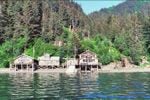TUXEDNI NATIONAL WILDLIFE REFUGE
TUXEDNI NATIONAL WILDLIFE REFUGE
In 1909 two islands at the mouth of Tuxedni Bay off of Cook Inlet--Chisik and Duck--were established as a refuge for seabirds, bald eagles, and peregrine falcons. In 1970 they were designated Wilderness and in 1980 became a subunit of the Gulf of Alaska Unit of the Alaska Maritime National Wildlife Refuge. Most of the refuge lies on Chisik Island (tiny, six-acre Duck Island is a rocky dot with almost no vegetation). Chisik slopes upward out of Cook Inlet from sandy beaches on the southern end to 400-foot cliffs on the northern end. A cannery located on the southern end occupies a small non-Wilderness area of the island.
An understory of salmonberry, alder, and other brushy growth forms an impenetrable, wet jungle over much of Chisik, filling the few openings in the spruce-hemlock forest. The higher elevations are alpine tundra from which the volcanoes of Mounts Redoubt and Iliamna in Lake Clark Wilderness often can be seen. Chisik Island has no trails. Camping is unrestricted. Hunting is not allowed, but fishing is permitted, with salmon being sought most often. Small planes and boats land here, but sudden winds and rough waters make access risky.



